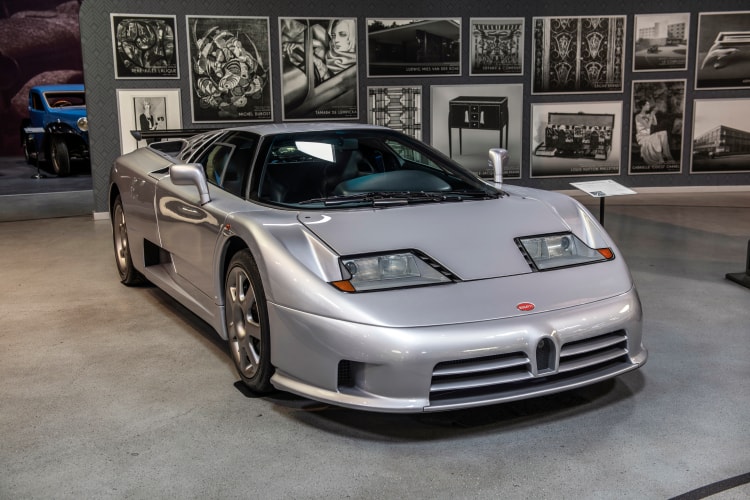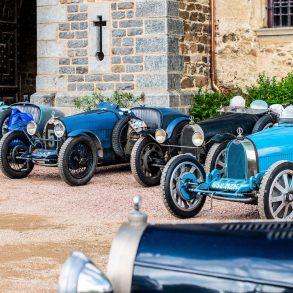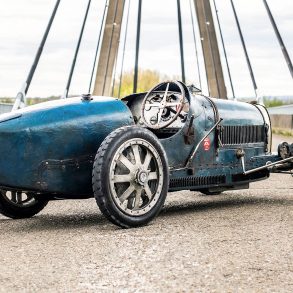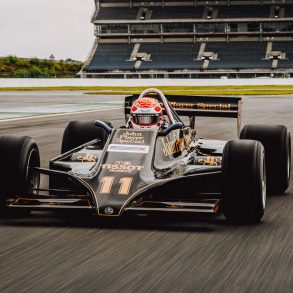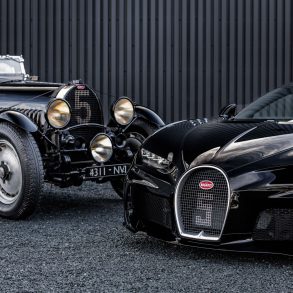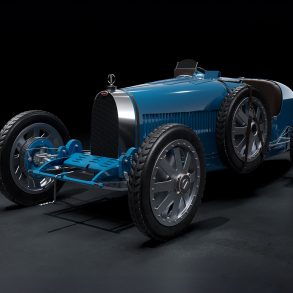This week’s Mullin Automotive Museum featured vehicle is the 1994 Bugatti EB110 Supersport ‘Le Mans’, one of only three vehicles of these specifications ever built. In all, two were produced for a significant collector in Japan with the EB110 at the Mullin Automotive Museum vehicle being one of them.
The Mullin Automotive Museum’s Bugatti display is breathtaking. In all, the museum has 50 Bugatti vehicles – the largest private collection of Bugatti automobiles in the world. The only larger collection is the French National Automotive Museum in Toulouse, France.
Development of the Bugatti EB110
The late twentieth century saw the rise of a new kind of supercar: overpowered, exotic, and wild vehicles that were tailored specifically for an elite group of car connoisseurs.
During this moment in time, supercars manufacturers of the likes of Lamborghini, Maserati, Lotus, and Ferrari dominated the market. Entering the supercar market was Italian entrepreneur Romani Artioli who resurrected the Bugatti marque in the form of Bugatti Automobili SpA to produce the Bugatti EB110.

A greater depth of the history and development of the Bugatti EB110 can be found within our review article that was published last year.
Bugatti Automobili SpA set a new standard for power, speed, and aesthetics. They built a modern design center and factory in Campogalliano, Italy, which houses many other high-performance car manufacturers.

To make his dream possible, Artioli recruited a group of highly respected and admired supercar designers.
The expertise of car stylist Marcello Gandini and engineer Paolo Stanzani, who worked together on the Lamborghini Countach, was acquired to conceive the EB110.
Architect Giampaolo Benedino oversaw the final styling of the car, ensuring they would have a body style that also embodied the old marque.
Exactly 110 years following the birth of Ettore Bugatti, being 15 September 1991, the Bugatti EB 110 GT was unveiled at two notable Parisian locations – the ultra-modern La Défense and the Versailles Palace.

The EB110 was remarkable for its day. Comprising an entire carbon fiber body, it featured a world-class engine built from scratch that could produce 553 horsepower and a top speed of 212 mph (0-60mph in 4.6 seconds).
Following the EB 110 GT, engineers, stylists, and designers worked together to create the ultimate supercar in the form of the Bugatti EB110 Supersport (EB110 SS).
It appeared about half a year later at the 1992 Geneva Motor Show as a concept, though Bugatti presented the EB110 Super Sport at the 1994 Geneva Motor Show.

The intention was to produce 150 EB 110 in total, however, by 1995, only 96 GT versions were produced, and 32 EB 110 SS were created. The last vehicles to leave the factory were two works race cars that competed in the 24 Hours of Le Mans and 24 Hours of Daytona.
Interior
Upon looking at the interior of the EB110 SS, it is clear that the focus was to save weight and be functional. Unlike the timber dashboard of the EB110 GT, the EB110 SS featured carbon fiber.

Overall, the EB110 SS design saved about 330 pounds in weight compared to the GT. Despite being spartan in the cockpit, it did in fact have air-conditioning, but few other luxuries. In fact the glovebox does not have a door on it, again designed to keep the weight down.

Engine
The EB110 Supersport ‘Le Man’s’ is equipped with a 3.5-liter, 60-valve V12 engine with four turbochargers giving it the capability to go from 0 to 60 mph in 2.94 seconds.

This particular engine was modified with a larger induction system and slightly larger turbochargers bumping up the output to 700 horsepower at 8250 rpm.

Owner History of the EB110 SS Le Mans
This EB110 SS Le Mans was previously under the custody of Japanese collector Yoshiyuki Hayashi. The vehicle was then imported into California after being purchased by former racecar driver Bruce Canepa.

In 2008, Peter Mullin acquired the car from Bruce Canepa to be part of the Bugatti marque collection. The example is in the United States strictly for display purposes, as it has no title documents.

Specification’s of the Bugatti EB100 SS Le Mans
| Chassis number | ZA9BB02E0RCD39022 |
| Body type | Supersport |
| Number made | 139 EB110, 3 EB110 SS Le Mans |
| Production span | 1991-1995 |
| Top Speed | 232 |
| Body | Aluminum and carbon/Kevlar fiber, mechanically fixed and bonded to the carbon chassis, integral roll cage, 2-door, 2 places |
| Chassis features | Carbon fiber composite manufactured by Aerospatiale/Bugatti |
| Front brakes type | Ventilated |
| Rear brakes type | Ventilated |
| Front suspension type | Double wishbone, pull-rod operated shock absorbers |
| Rear suspension type | Double wishbone, twin gas-pressure shock absorbers |
| Length | 14’ 5” |
| Height (Ground line to highest roof) | 3’ 9” |
| Width | 6’ 4” |
Engine Details
| Engine number | 0123 |
| Number of cylinders | 12 |
| Engine construction | Aluminum |
| Engine position | Longitudinally mounted mid-engine |
| Displacement | 3498 |
| Distribution | 4 turbochargers; double-overhead camshaft |
| Fuel feed system | Bugatti multipoint fuel injection |
| BHP at 8250 RPM | 612 |
| Transmission | 4-wheel drive, 7-speed transmission |
| Gearbox | Manual |
| Number of gears | 6 |
| Overdrive | 0 |
[Source: Mullin Automotive Museum]


